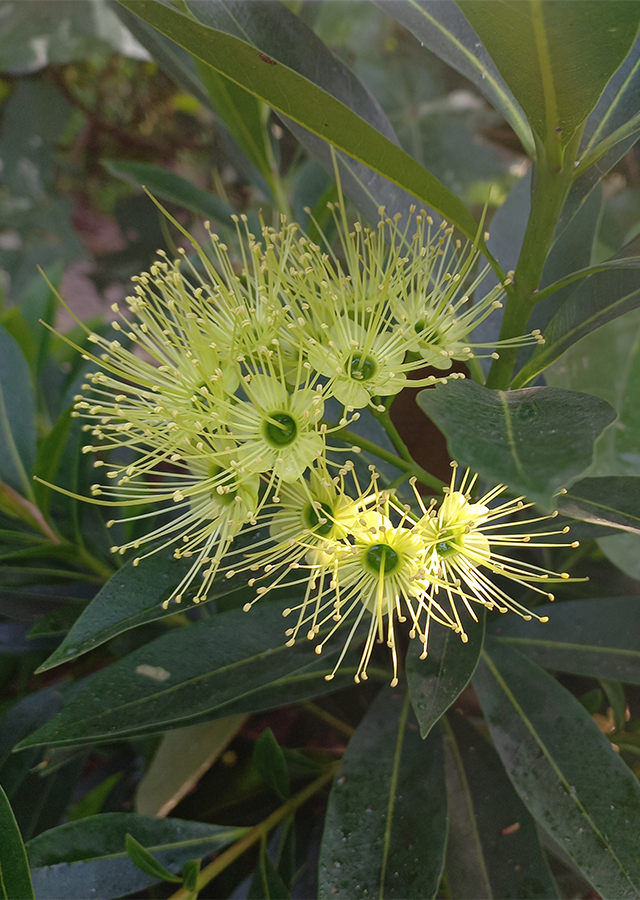Golden Penda
Xanthostemon chrysanthus (F. Muell.) Benth.
Myrtaceae
Location in our garden
Principal



Synonym
Metrosideros chrysantha F.Muell.
Habitus
Shrubs. An evergreen tropical perennial tree, 8-12 m in height under cultivation, but up to 40 m in its native environment.
Part Used
Leaves
Stem
Growing Requirements
Full Sunshine
Habitat
Forest
Terrestrial
Overview
Xanthostemon chrysanthus is an endemic and native to Queensland, Australia. Distributed and grow naturally in New Guinea, Solomon Island, Malaysia, Indonesia and the Philippines. Genus name derived from Greek ‘xantho’ and Latin ‘stamen’, meaning yellow thread. Species epithet refers to gold and flower, derived from Greek words ‘khrusos’ and ‘anthos’. It is widely planted for urban beautification due to its distinctive coloured flowers. Owing to its bright yellow and unique flowers, this species was introduced for ornamental purposes and has then become one of the popular landscape trees for roadsides, urban parks and residential areas.
Vernacular Names
Jīn pú táo (Chinese), Jambu kuning (Malaysia).
Agroecology
Grows in areas with annual rainfall 1.200 - 2.500 mm and temperature of 10 - 34 °C, respectively, with 76.4% average relative humidity. Needs podsolic and aluvial soils, with well-drainaged. This species is preferred for urban planting because it is able to tolerate the harsh urban environment and it flowers throughout the year.
Morphology
- Root - taproot system.
- Stem - woody, scaly, smooth mature bark.
- Leaves - lance-shaped, 8-20 cm x 1.5-5 cm, flat serrate margin, arranged spirally, dark green and leathery. Young flushes appear bronze-red.
- Flowers - bright yellow and bisexual with 5 petals attached to rim of calyx. Yellow stamens about 3 cm, surround centrally located style that is 3-4 cm long.
- Fruits - capsules, turn from green to brown upon maturation. Seeds are dispersed by explosive action.
Cultivation
Propagated by seeds or stem cuttings, relatively easy to grow, fast growing and low maintenance. Flowering believed to be induced by sudden drop in temperature and can begin 2-3 years after been grown from seeds.
Chemical Constituents
β-triketone leptospermone, cinnamoyl-phloroglucinols.
Traditional Medicinal Uses
- In traditional medicine, it purifies the blood, to treat liver and lung complaints.
- Study has shown cytotoxic activity.
Part Used
Reference Sources
- Ahmad Nazarudin, M.R., and Tsan, F.Y. (2018). Vegetative Reproductive Growth Behaviour of Xanthostemon chrysanthus (F. Muell.) Benth. – An Ornamental Tree in Malaysia.Sains Malaysiana 47(2)(pg.227-233).Sains. http://dx.doi.org/10.17576/jsm-2018-4702-03. 01-12-2021.
- Brophy, J.J., and Goldsack, R.J. (2006). A Preliminary Examination of the Leaf Oils of the Genus Xanthostemon (Myrtaceae) in Australia. Journal of Essential Oil Research,18(2) (pg.222-230). DOI:10.1080/10412905.2006.9699071.
- Eko, M. (2020). Xanthostemon chrysanthus (F, Muell.) Benth, Golden Penda, Tanaman Peneduh Berbunga Kuning yang Indah. https://www.planterandforester.com/2020/11/xanthostemon-chrysanthus-f-muell-benth.html. 01-12-2021.
- Liu, F., Lu, Wei-Jin, et al. (2018). Four new cinnamoyl-phloroglucinols from the leaves of Xanthostemon chrysanthus. https://pubmed.ncbi.nlm.nih.gov/29778572/. 01-12-2021. 01-12-2021.
- National Park of Singapore (2021). Flora & Fauna Web: Xanthostemon chrysanthus (F.Muell.) Benth. https://www.nparks.gov.sg/florafaunaweb/flora/3/2/3200. 01-12-2021.

